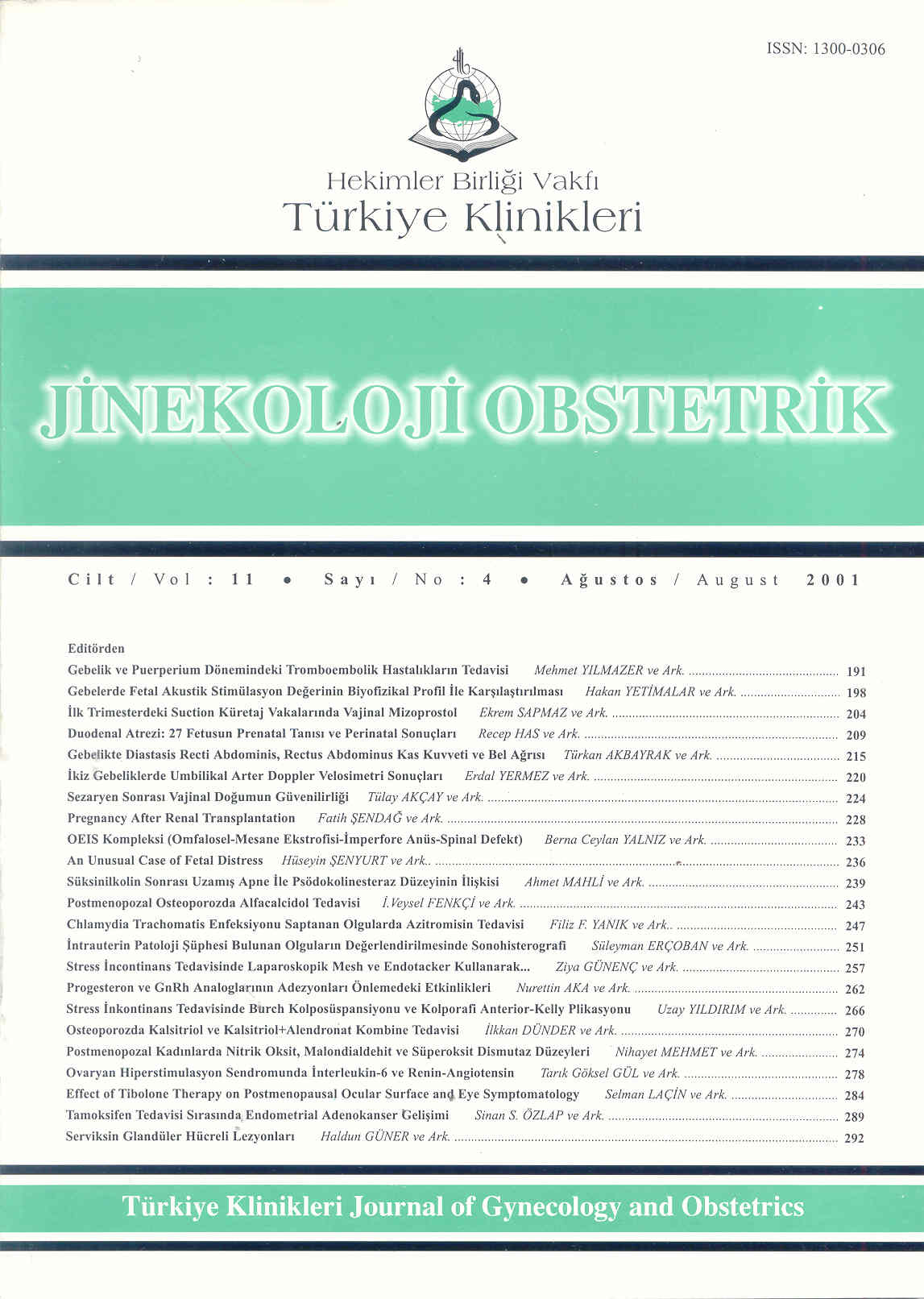Open Access
Peer Reviewed
ARTICLES
3598 Viewed2248 Downloaded
The Relationship Of Serum Pseudocholinesterase Levels Andprolonged Apnea Following Succinylcholine Administration: Two Cesarean Section Cases
Süksinilkolin Verilmesinden Sonra Görülen Uzamış Apne ile Psödokolinesteraz Düzeyininİlişkisi: İki Sezaryen Olgusu
Turkiye Klinikleri J Gynecol Obst. 2001;11(4):239-42
Article Language: TR
Copyright Ⓒ 2025 by Türkiye Klinikleri. This is an open access article under the CC BY-NC-ND license (http://creativecommons.org/licenses/by-nc-nd/4.0/)
ÖZET
Amaç: Psödokolinesteraz (PChE) düzeyleri düşük olan ve sezaryende farklı anestezi yöntemleri kullanılan iki olgunun sunumu. Çalışmanın yapıldığı yer: Gazi Üniversitesi Hastanesi, Beşevler Ankara. Materyal ve metod: PChE eksikliği olan iki olgunun birisinde süksinilkolin kullanılarak genel anestezi, diğerinde ise spinal anestezi kullanılarak postoperatif durumları araştırıldı. Bulgular ve sonuçlar: Sezaryen ameliyatı nedeni ile genel anestezide süksinilkolin verilen olguda ameliyat sonrası 4 saat süren apne durumu oldu. Bu olguda kan PChE düzeyi 798 U/L (normal değerler 4300-11500 U/L) idi. Daha önce geçirdiği sezaryende uzamış apne öyküsü öyküsü olan ikinci olguda ise kan PChE düzeyi 400 U/L bulunmuş olup spinal anestezi uygulanmıştır. Sonuç olarak sezaryen ameliyatı geçirecek olgularda PChE eksikliği, nöromusküler blokaj süresi daha da uzadığı için özellikle homozigot enzim varlığında en uygun anestezi yönteminin, apne gelişmesi durumunda ise uygun tedavinin tam olarak verilmesi gerekliliği gösterilmiştir.
Amaç: Psödokolinesteraz (PChE) düzeyleri düşük olan ve sezaryende farklı anestezi yöntemleri kullanılan iki olgunun sunumu. Çalışmanın yapıldığı yer: Gazi Üniversitesi Hastanesi, Beşevler Ankara. Materyal ve metod: PChE eksikliği olan iki olgunun birisinde süksinilkolin kullanılarak genel anestezi, diğerinde ise spinal anestezi kullanılarak postoperatif durumları araştırıldı. Bulgular ve sonuçlar: Sezaryen ameliyatı nedeni ile genel anestezide süksinilkolin verilen olguda ameliyat sonrası 4 saat süren apne durumu oldu. Bu olguda kan PChE düzeyi 798 U/L (normal değerler 4300-11500 U/L) idi. Daha önce geçirdiği sezaryende uzamış apne öyküsü öyküsü olan ikinci olguda ise kan PChE düzeyi 400 U/L bulunmuş olup spinal anestezi uygulanmıştır. Sonuç olarak sezaryen ameliyatı geçirecek olgularda PChE eksikliği, nöromusküler blokaj süresi daha da uzadığı için özellikle homozigot enzim varlığında en uygun anestezi yönteminin, apne gelişmesi durumunda ise uygun tedavinin tam olarak verilmesi gerekliliği gösterilmiştir.
ANAHTAR KELİMELER: Psödokolinesteraz, Sezaryen, Süksinilkolin, Spinal anestezi
ABSTRACT
Objective: To present two cesarean section cases with low serum levels of pseudocholinesterase (PChE) who had different types of anesthesia. Institution: Gazi University Hospital, Beşevler Ankara. Materials and methods: One of two cases with PChE deficiency had succinylcholine during general anesthesia, the other case had spinal anesthesia. Their postopeative conditions have been investigated. Results and Conclusion: There was prolonged apnea of 4 hours in patient who had succinylcholine during general anesthesia. In this case serum PChE level was 798 U/L (normal values 4300-11500 U/L). The other patient who had developed prolonged apnea due to succinylcholine use during previous cesarean section had serum level of 400 U/L. She had spinal anesthesia during her repeat section. As a result, patients with PChE, especially those with atypical homozygote enzyme, should have appropriate anesthesia during cesarean section, and in case of prolonged apnea appropriate treatment should be given.
Objective: To present two cesarean section cases with low serum levels of pseudocholinesterase (PChE) who had different types of anesthesia. Institution: Gazi University Hospital, Beşevler Ankara. Materials and methods: One of two cases with PChE deficiency had succinylcholine during general anesthesia, the other case had spinal anesthesia. Their postopeative conditions have been investigated. Results and Conclusion: There was prolonged apnea of 4 hours in patient who had succinylcholine during general anesthesia. In this case serum PChE level was 798 U/L (normal values 4300-11500 U/L). The other patient who had developed prolonged apnea due to succinylcholine use during previous cesarean section had serum level of 400 U/L. She had spinal anesthesia during her repeat section. As a result, patients with PChE, especially those with atypical homozygote enzyme, should have appropriate anesthesia during cesarean section, and in case of prolonged apnea appropriate treatment should be given.
MENU
POPULAR ARTICLES
MOST DOWNLOADED ARTICLES





This journal is licensed under a Creative Commons Attribution-NonCommercial-NoDerivatives 4.0 International License.










